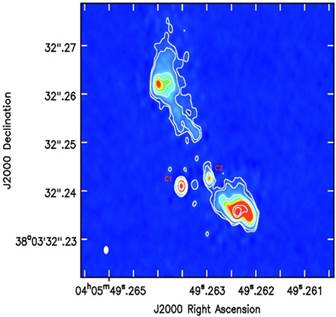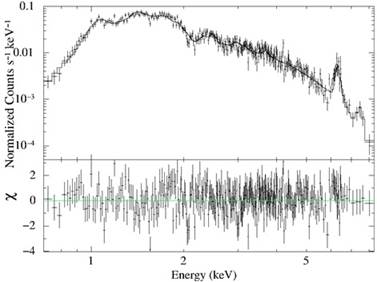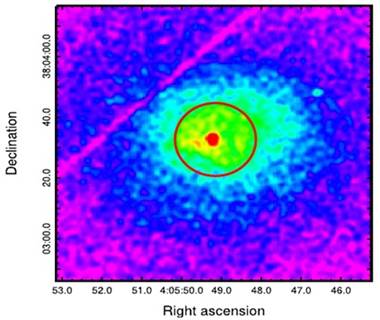Figure Caption: The Chandra X-ray image of the core of 4C+37.11. The red circle is the region considered for spectral analysis.
Iron Lines in X-ray have been detected from a well-known binary black hole system in the radio galaxy 4C+37.11 750 million light years away from the Earth, making way for study of the properties of the system. This is the first time that X-Ray has been detected in a binary system — a system of two astronomical bodies that orbit a common center of mass and are gravitationally bound. The lines can help understand properties of the black hole.
The centers of all galaxies are known to host supermassive black holes (SMBHs), which have masses between a million to a billion times that of the sun. It is not easy to understand how the gas surrounding these black holes moves in its gravitational field, but X-ray observations offer a way to study the inner parts of these objects. However, radiation coming from the central SMBHs plays a critical role in illuminating the circumnuclear environment, which gives rise to various emission and absorption spectral lines. One of the most important is the Fe K emission line in the X-ray spectra from Iron atoms. These lines serve as important diagnostic tools for probing the physical conditions of the gas surrounding black holes, such as the temperature, density, and ionization state.
A study led by astronomers at the Indian Institute of Astrophysics (IIA) an autonomous institute of Department of Science and Technology, have detected the Fe K spectral lines of ionized Iron atoms from the well-known binary Active Galactic Nucleus system 4C+37.11 using data from the Chandra Space Telescope. They concluded that this emission arises from both the accretion disk and the collisionally ionized plasma surrounding the pair of supermassive black holes in this object.
“We decided to look at 4C+37.11, which is one such fascinating and unique astrophysical object. It is one of the few confirmed binary active galactic nuclei (bAGN) located about 750 million light years away from the Earth, and is a very well-studied system of its kind”, said Santanu Mondal, a Ramanujam Fellow at the Indian Institute of Astrophysics, and lead author of the paper published about this work. Discovered in 2004, this system consists of two SMBH nuclei separated by a distance of only about 23 light years. “The proximity of these two SMBHs makes 4C+37.11 a rare and valuable case for studying the dynamics and interactions in such extreme environments.
“Although Fe K emission lines have been detected from many nearby SMBHs, it has never been detected in this SMBH binary system. Such a spectral line can reveal facts about the merging of SMBHs, which is even known to produce gravitational waves at their final moments at merger”, said Mousumi Das of IIA and a co-author of the study.
“We studied 4C+37.11 using archival data from Chandra, and discovered two Fe K lines for the first time. Through modelling, we could infer that this line emission originates from the combined effects of the accretion disk around the supermassive black holes and the collisionally ionized plasma surrounding them”, said Mondal. The team also determined the total mass of the binary SMBHs to be 15 billion times that of the Sun, rotating with a moderate or low spin of less than 0.8.
“Our study shows that detecting the Fe K line emissions from binary supermassive black holes is important for estimating the individual black hole masses and their spins, as well as exploring the emission regions and the behavior of matter around them and radiation in extreme conditions”, said Mousumi Das.
The results of the study by Santanu Mondal and Mousumi Das from IIA, Aniket Nath from NISER, Rubinur Khatun from Norway, Karishma Bansal from USA and Greg B. Taylor from the University of New Mexico, USA have been published in the Astronomy & Astrophysics (A&A) journal.

Figure caption: The VLBA image of the bAGN system 4C+37.11, where C1 and C2 denote the well-resolved two cores hosting SMBHs and one of them, C2 is showing a prominent jet

Figure caption: The X-ray spectrum of the system in the 0.7-8.5 keV band extracted from the Chandra observations, fitted with combined models of accretion disk and collisionally ionized plasma. The lower panel is showing the residual of the fit. Two Fe K lines are clearly visible at ~6.62 keV and ~7.87 keV energies.
***
NKR/PSM





